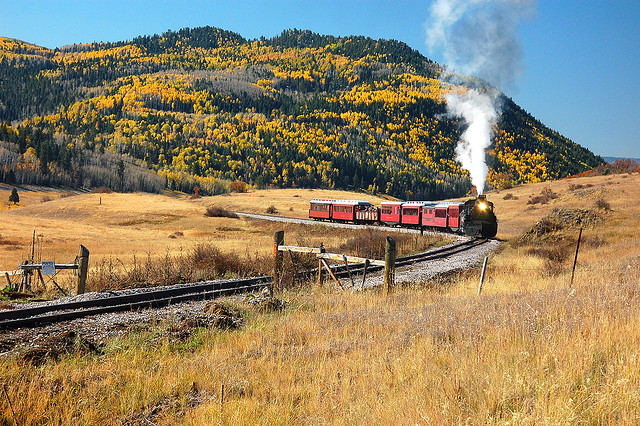Winding over 64 miles through the majestic San Juan mountains, the narrow-gauge railway known today as the Cumbres and Toltec Scenic Railroad was built as a branch of the extensive Denver and Rio Grande Western Railroad that ran through western Colorado and most of Utah. It originally served the large number of settlers flocking to the gold and silver mines of the region.
With few passable roads available, residents relied on the railway as their primary means of passenger and freight transportation through the 1920s. Although passenger service ended in 1950, the discovery of natural gas helped extend the line's usefulness for hauling freight - including livestock and crude oil - through the 1960s. Colorado and New Mexico jointly purchased the line in 1970, creating an unparalleled tourist attraction that has since carried more than a million riders during the summer months through some of the most spectacular terrain in the American West.
Facts
- The railway's most impressive bridge consists of seven 54-foot spans that carry the line 137 feet above Cascade Creek. Not far away is the Mud Tunnel, a 342-foot bore built through volcanic clay that flows when wet, requiring that the tunnel be fully lined with timber. To climb one steep grade, the track is forced to double back on itself twice, resulting in that section being known as "The Whiplash."
- The railway is named for the most-prominent features on its route -- the 1,000-foot Toltec Gorge of the Los Piqos River, considered one of the sheerest drops in the United States, and Cumbres Pass, at 10,015 feet the highest railroad pass in the country.
- The Cumbres and Toltec railroad was built whenever possible on south-facing slopes to take advantage of maximum sun exposure, helping to melt the heavy accumulations of winter snow common in the mountains.
- Between 1870 and 1880, the population of Colorado -- which became a state in 1873 -- increased fivefold, to nearly 200,000.
- The prosperity of the 1920s allowed the railroad's owners to order new, more-powerful locomotives and several more-modern railroad cars, all of which are still in service today.
- An account of several months spent traveling the Denver and Rio Grande Western Railroad was published by Ernest Ingersoll in 1885 as The Crest of the Continent. It sold nearly 100,000 copies before going out of print in 1901.
Resources
- Ernest Ingersoll, The Crest of the Continent (reprint); Rio Grande Press, 1971.
- Spencer Wilson, The Cumbers and Toltec Scenic Railroad: The Historic Preservation Study (Albuquerque: University of New Mexico Press, 1980).



